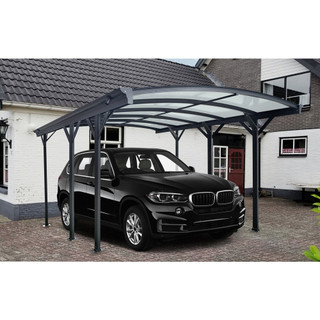Leaving your car uncovered and outside for extended periods may seem harmless, but many damaging forces are working against you. In the heat of summer, the sun’s rays can damage both the interior and exterior surfaces of your vehicle significantly. Exterior paint, especially on red and darker cars, fades much more quickly in direct sunlight than in the shade. This not only creates an expensive-to-repair eyesore but also devalues your vehicle and the perception of it. The harsh UV rays in sunlight can gradually strip paint off of a car, exposing bare metal and significantly increasing the likelihood of rust. Car interior colors fade much more quickly when exposed to direct sunlight, and the damage is even more pronounced in the cracks and splits that develop in leather and hard plastic components.
Studies have shown that a car dashboard can be over 40 degrees (F) hotter after sitting in the sun as compared to the shade, and cars in the shade cool off almost twice as fast as cars in the sun (12 minutes vs. 21 minutes). Getting in your vehicle in the summer is much more pleasant when your steering wheel and seat belt aren’t scorching hot, and your car cools down in a reasonable amount of time. More quickly than you might think, this daily damage adds up into noticeable deterioration, which is mostly and easily preventable.
The cold winter months can be equally damaging to your car, particularly on the exterior. Parking your car on the street is especially detrimental during the winter months, in large part because of the salt and de-icing compounds used to keep the roads free of snow and ice. These compounds corrode paint quickly, and get thrown all over the road by salt trucks and plow trucks alike. When ice and snowmelt and freeze in direct contact with the metal of your car, rust build-up is unavoidable. Rust on vehicles is more than just an eyesore as well. Rust degrades the metal on cars, both on the exterior panels and frame underneath, which could eventually become the cause of a failed vehicle inspection. Rust damage on the components along the underside of your car is also problematic, often going unnoticed until becoming a significant issue. If left unchecked, vital components may buckle or break when hitting a bump or a pothole, which could have catastrophic consequences.
Aside from the threat of rust damage, winter precipitation guarantees that you will be spending time and energy scraping snow and ice off of your uncovered car. Failure to remove the ice and/or snow on your vehicle before starting your drive is illegal in most states that receive regular snow, with states such as Pennsylvania having a maximum fine of $2000. Even when taking great care and using the proper tools to remove the snow and ice, you are still likely to leave scratches in your car’s paint, which becomes evident after even just one season of scraping. Valuable time is wasted trudging around the car while clearing the view, and it seems impossible to keep yourself free of snow in the process. Nobody should have to start their morning commute in such a state.
In an ideal world, every driver would have a dedicated indoor garage space to house their vehicle when not in use, but that is far from reality. Most homes do not have the storage space to accommodate vehicles, along with all of the other miscellaneous items that find their way into totes and boxes in the garage. Some homes may not even have a garage at all! This does not mean that your car or truck has to suffer; several alternative solutions could help protect your assets with little effort on your part.
Roughly one out of every four Americans with a garage say that it is too cluttered to fit a car, according to an April 2015 homeowner survey from Gladiator Garageworks. If you belong to this group whose garage is more of a storage locker than a carport, you will find that there are easy ways to declutter and open up space you could be using to protect your vehicle. Freestanding storage sheds are an inexpensive way of storing your items out of the way, but still having them available for use when you need to use them. Storage sheds come in a wide variety of shapes and sizes to fit all storage needs and lot sizes, and installation is more straightforward than you may think. A smartly placed freestanding shed can make a world of difference when organizing your home. Moving your most substantial items from the garage to the storage shed and finding creative ways to make use of wall space for hanging storage could have your garage car-ready with minimal effort.
If the garage is already occupied by another car, consider installing a carport on your property where you typically park. This will give you all of the benefits of covered parking without actually taking up any space within your home. Carports have come a long way in both visual appeal and functionality, and are another way of quickly obtaining protection for your vehicle. New polycarbonate panel technology is both stronger and lighter than glass, and carport structures as a whole have been smartly redesigned to provide maximum protection for what is below.
As explained by Donald Shoup in his book “The High Cost of Free Parking,” cars are parked roughly 95% of the time. Although you may think your car is safest when it is parked, many destructive forces at work can easily be minimized or removed altogether. Using a freestanding storage shed to free up space in the garage or installing a carport could save thousands in the long run, and each can be installed relatively easily. Start taking contentment in the care of our vehicles again, both while in use and while idle.
